Nanoparticle Formation: A Modular High Pressure System to Enhance Biopharmaceutical Properties of Poorly Soluble Drugs
A modified modular high-pressure system can form nanosuspensions of model compounds by individually controlling cavitation, impact, and shear forces.
Pharmaceutical research and development scientists have applied combinatorial chemistry and molecular modeling techniques to develop drug compounds with properties more closely resembling natural mediators in the body. Many of these natural mediators are hydrophobic substances and are synthesized at or near the site of action; thus they do not need to overcome the absorption, distribution, metabolism, and excretion issues associated with administered drugs. To overcome the challenges of absorption and distribution resulting from hydrophobicity and poor solubility, formulators have developed drug delivery systems such as solid dispersions, microemulsions, self-emulsifying systems, complexation, liposomes, and nanostructured particles created using particle-size reduction and particle-formation techniques.
Nanotechnology in particular has several advantages. The approach improves bioavailability, decreases fed fasted variability, and results in a faster onset of therapeutic action for oral doses. Moreover, supersaturation can be achieved with nanonization using mechanical techniques that do not require conversion from a crystalline to an amorphous state (1, 2).
Particle size plays an important role in the dissolution rate of a drug. Studies of poorly soluble drugs have demonstrated that reducing the particle size can increase the rate of dissolution and provide a higher bioavailability (3, 4). The majority of these studies involved a mechanical size reduction to particles larger than 1 μm (5). Kondo et al. reported the bioavailability for HO-221 doubled when the mean particle size was reduced from 4.15 to 0.45 μm (6). These studies demonstrate the potential for substantially enhancing bioavailability by particle-size reduction to the submicron range. Liveridge and Cundy (7) reported the absolute bioavailabilities of a nanoparticle donazol formulation (82.3 ± 10.1%) and an aqueous suspension of conventional donazol particles (5.1 ± 1.9%), which suggest that the nanoparticle dispersion can overcome the dissolution rate–limited bioavailability observed with a conventional suspension of donazol.
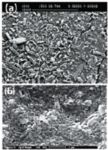
Figure 1: Scanning electron photomicrographs of (a) unprocessed investigational compound 2 (INV 2) (scale 100 μm) and (b) processed INV 2 (scale 1 μm).
The current study evaluates the feasibility of nanoparticle formation by modulating, in a controlled manner, cavitation, shear, and impact forces. A technique that individually controls these forces to form stable nanoparticle suspension was evaluated, developed, and shown to provide a higher process intensity and to process a much higher solids concentration (more than 60% w/w) (see Figure 1).

Figure 2: Photo of (a) the pilot-scale system and (b) the modular process cell and (c) flow couplings, nozzle, cells, seals, and cell retainer (left to right). Absorption cell (reactors and seals) options include various numbers of reactors to control process duration, various reactor geometric designs and sizes to increase or decrease shear, laminar flow (for delicate emulsions), or turbulent flow (for greater impact and reprocessing). Nozzle options include various geometries and sizes, and flow coupling options allow laminar or turbulent flow to minimize or increase cavitation, respectively.
Equipment design
A modular high-pressure system providing an improved individual control over cavitation, impact, and shear forces to accommodate varying solid fracture characteristics of various active pharmaceutical ingredients (APIs) was used to form nanosuspensions (8) (see Figure 2a). Components of a typical modular process cell include a flow coupling device, nozzle, process cells, seals, and cell retainers (see Figures 2b and 2c). The nozzle size can be changed to accommodate various viscosities, flow rates, pressures, and cavitation (flow rates are typically 225–1800 mL/min on pilot-scale equipment). The flow coupling option (before the nozzle) can provide either turbulent flow for premixing and increased cavitation or laminar flow to reduce cavitation (see Figure 3).
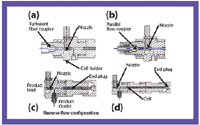
Figure 3: Flow coupling options: (a) turbulent flow, (b) laminar flow, (c) short processâreverse flow, in which fewer cells and seals provide maximum process intensity with higher impact and lower shear, and (d) long processâreverse flow, in which the increased process duration increases fluid on fluid impact and shear, and reverse flow provides additional impact to further reduce particle size.
The turbulent flow coupling option helps break agglomerates before they approach the nozzle and prevents nozzle plugging at higher solids concentrations. The nozzle converts the highly pressurized (≤45,000 psi) suspension into a high-velocity jet. The process cells (absorption cells) positioned after the nozzle absorb the kinetic energy from the high-velocity jet. The cell number controls the process duration, and the cell geometry dictates the overall shear imparted. By changing the seal internal diameter (i.d.) between the absorption cells, turbulent (i.e., the seal i.d. is larger than cell i.d.) or laminar (i.e., the seal i.d. is the same as cell i.d.) flow can be induced.
Unlike wet milling, in which the primary forces are impact and shear, or piston gap homogenization, in which the primary force is cavitation and secondary forces are impact or shear, the modular high-pressure system can individually control impact, cavitation, shear, and flow (turbulent or laminar) (9, 10). In addition, back pressure can be controlled (0–5000 psi) to increase or decrease overall process duration and cavitation. The modular system avoids disadvantages inherent in wet milling such as erosion, discoloration, fractionation, low solids concentration (typically 10–30%), and the risk of bacterial growth requiring depyrogenation. The modular system also does not have the disadvantages associated with piston gap homogenization such as preprocessing requirements (e.g., microprecipitation or premilling using jet mill or hammer mill to reduce the initial particle size); low suspension viscosity requirements; little control over the choice of cavitation, shear, or impact; interaction of fluids in a relatively small space and time; higher impact on machine leading to wear, which can enter the process stream; or fixed process geometry. The modular high-pressure system used in the current study not only provided individual control over cavitation, shear, and impact but also allowed solids concentrations >60% w/w to be processed at operating pressures ≤45,000 psi.
Materials
Materials included investigational (INV) compounds 1, 2, and 3 (solubility range 0.001–0.094 mg/mL); naproxen (model drug) (TCI, Japan); sodium lauryl sulfate (SLS) (Akzo Chemicals Ltd., Edison, NJ); Tween 80 (Croda, New York, NY); Avicel PH 101 (FMC BioPolymer, Philadelphia, PA), Fast Flo lactose (Foremost, Baraboo, WI); Cab-O-Sil fumed silica (Cabot Corp., Boston, MA); magnesium stearate (Mallinckrodt, St. Louis, MO); polyvinylpyrrolidone (PVP) K-30 (ISP, Wayne, NJ); croscarmellose sodium (FMC, Philadelphia, PA); pluronics (BASF, Parsipanny, NJ); and hydroxypropyl cellulose (HPC)-SL (Nissa America, New York, NY). Naproxen was used for comparison because it has been widely used as a model, including media milling.
Equipment and instruments
The following equipment were used: DeBee 2000 modular high-pressure system (model 2510, BEE International), mixer to prepare coarse suspension (model L4R, Silverson), Tekmar mixer, Haake twin-screw mixer for wet granulation (Thermo Electron Corp.), spray-dryer for the formation of redispersible nanoparticles (Yamato Scientific America), fluid-bed dryer for spray granulation (Strea model, Niro Pharma Systems), pump to inject the nanosuspension into the twin-screw granulator (Ivek Corp.), feeder to feed excipients into the twin-screw granulator (K-Tron), mill for dry granulation (Comil model, Quadro), V blender for final blending before tableting (Patterson Kelly), mixer for final blending before tableting (Turbula T2, Glen Mills), compaction simulator for tableting (Presster, Metropolitan Computing Corp.), moisture analyzer (Computrac, Arizona Instrument Corp.), tablet disintegration tester (Erweka), particle-size analyzer (ensemble technique for particle size and distribution characterization) (model LS 230, Coulter), particle-size analyzer (ensemble technique for particle size characterization) (Brookhaven 90 Plus, Brookhaven Instruments), UV-visible spectrophotometer HP8453 for dissolution studies (Agilent), and a dissolution tester (VanKel VK7010 Type II, Varian).
Methods
Coarse suspension was processed using various cell configurations. A predetermined quantity of a surfactant and/or polymeric stabilizer was dissolved in appropriate quantity of USP water. The surfactant solution was then poured in a stainless steel vessel containing the drug substance. A Silverson mixer operating at 800 rpm was used to wet and achieve a uniform, relatively stable coarse suspension. The suspension was transferred into the reservoir of the high-pressure system for further processing.
Discrete passes were used to nanosize the coarse suspension. A 100-μm nozzle operating at a 45,000 psi pressure generated a flow rate of ~500 mL/min; therefore, a 1-L batch size achieved one discrete cycle in 2 min. As the drug loading was increased, the steric and ionic stabilizer concentrations also were increased proportionately. Wet granulation with a twin-screw or fluid-bed granulator was performed to form a redispersible powder, which was blended with extra-granular excipients to form solid dosage forms. A compaction replicator (Presster) simulating Betapress 16 station (turret speed = 50 rpm) was used to make 500-mg INV 1, 200-mg INV 2, and 750-mg naproxen tablets. Orthogonal particle-size characterization techniques including ensemble (i.e., laser diffraction and differential light scattering) and single-particle (i.e., microscope) characterization were used to determine mean particle size and distribution.
Results and discussion
Effect of process duration. The mean particle size and distribution decreased as the process time increased (see Figure 4). An important observation we noted was that the first few passes typically reduced the particle size considerably and the size distribution also was considerably narrower compared with that of the coarse suspension. API mass distributions, normalized by area, were determined using laser diffraction (see Figures 5a and 5b). Nanoparticles can be achieved irrespective of the initial particle-size distribution of the coarse suspension and preprocessing is not required to prevent nozzle clogging, which is usually observed when typical piston gap homogenizers are used.
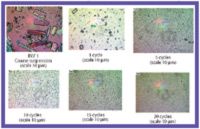
Figure 4: Photomicrographs takenn with an optical microscope. Photos show the effect of the number of cycles on particle size.
Effect of operating pressure and back pressure. Increasing the operating ≤45,000 psi results in significant reduction in the particle size of INV 1 (see Figure 6). Operating pressure had a greater influence on the larger particles (dvol90 values) than on the smaller particles (dvol10 values). Although the differential pressure (i.e., the operating pressure minus the back pressure) had a direct effect on the kinetic energy imparted to the expanding fluid, it also controlled the residence time of the fluid within the reactors. The relative contribution of each of these mechanisms dictated the final particle size. Typical piston gap arrangements have no control over the back-pressure.
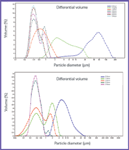
Figure 5: Effect of process duration on particle-size reduction (laser diffraction data) for (a) 20% w/w INV 1 and (b) 60% w/w INV 3. Note that a three-hour sample was not collected for INV 3. The mass distribution narrows and shifts to smaller size with increasing processing time. Increasing process duration results in lower mean particle size and narrower particle size distribution.
Effect of concentration. The concentration of solids in the material being processed dictates final particle size through two competing mechanisms. An increase in concentration results in an increase in the particle–particle attrition within the reactors. Although particle attrition as a function of the surface tension of the fluid (cavitation) also can play a role, it is treated as independent of the solid concentration for the purposes of simplicity. The influence of change in the fluid's surface tension, if any, as a result of an increase in concentration was not taken into account. The results of various concentrations of INV 1 at two levels of surfactants are shown in Table I.

Figure 6: Photomicrographs demonstrating the effects of operating pressure and back pressure on particle size: (a) shows the results after applying an operating pressure of 40,000 psi and a back pressure of 3000 psi, and (b) shows the results after applying an operating pressure of 40,000 psi and a back pressure of 0 psi. Six cycles were used for each experiment.
Effect of temperature. The primary effects of temperature on the processability of suspensions are mediated through alterations in properties such as viscosity, surface tension, kinetic energy, particle hardness, and so forth. Temperature also influences the tendency of the particles to agglomerate, which is more prominent in processes involving multiple cycles. These secondary effects were evident in INV 1 suspensions in which the temperature control was tested using two sinks (at <15 °C and 30 °C). The effect of this temperature on the particle size of INV 1 suspensions is shown in Figure 7. No significant differences are seen in the dvol10 and dvol50 values of the suspensions processed at various temperatures. On the other hand, the dvol90 value of the material processed at 15 °C is significantly lower compared with that at 30 °C. Given that the dvol90 value is significantly influenced by the larger particle sizes, the behavior can be attributed to particle agglomeration at higher temperature (i.e., the cloud point of a surfactant–stabilizer system). In summary, temperature control during processing is important to consistently produce and retain particles in a discrete nonagglomerated state.

Table I: Effect of concentration.*
Effect of ionic and steric stabilizer type and concentration. The type and amount of surfactant and polymeric stabilizer play important roles in stabilizing the nanoparticles because they form a surface charge on the suspended phase that stabilizes the colloid by electronic repulsion. The dielectric permittivity of the solution phase can be adjusted with buffer or neutral salts. Typical surfactants include sodium lauryl sulfate (SLS), bile salts, phospholipids, and polysorbates. Moreover, polymeric surface-active modifiers such as ethyl cellulose, hydroxypropyl cellulose, hydroxypropyl methylcellulose, polyvinyl pyrrolidone, and poloxamers provide steric repulsion, volume restriction, or osmotic repulsion.
Typically, a combination of steric and electrostatic stabilization is most effective. For INV 2 several surfactant and stabilizer combinations were evaluated (see Table II). A surprisingly low concentration of stabilizers was required to form stable nanoparticles. The nonionic surfactant polysorbate 80 was less effective in stabilizing the particles and preventing agglomeration, whereas the anionic surfactant SLS was more effective. Anionic surfactants containing the sulfonate group (e.g., docusate sodium or DSS) approved for intramuscular injectables, orals, topicals, and vaginal applications were most efficient. Particles having a mean volume diameter below 200 nm were formed. For higher drug loading, lower viscosity steric stabilizers such as polyvinyl pyrrolidone were more effective (see Table II).
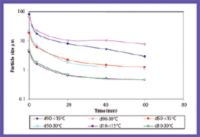
Figure 7: Effect of process temperature (INV 1) on particle size.
For INV 1, as much as 1% anionic surfactant was required to stabilize 20% w/w drug loading (see Table III). For INV 3, at 10% w/w loading the nanosuspension was stable at room temperature over a 0–2.5% w/w range of steric stabilizer.

Table II: Effect of surfactant and polymeric stabilizer (type and concentration)*
Physical stability of nanosuspension
The small size of colloidal particles implies that the relationship between area and volume is very strong for these systems, and the same can be said about the particles' surface energy. The spontaneous tendency of such systems should be the aggregation of single particles to minimize the total energy, unless an energetic barrier would hinder it. From a thermodynamic perspective, the formation of an interface must provide positive work to increase the surface area. The Gibbs free energy change ΔG, associated with the formation of a dispersed phase is positive, and, therefore, a colloidal dispersion is thermodynamically unstable (11). Figure 8a shows a two-month physical stability of INV 1 nanosuspensions stored at a 2–8 °C temperature range, thereby indicating the suspension has sufficient activation energy to prevent aggregation and the surfactant mixer prevents aggregation.
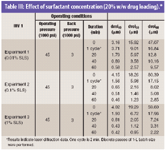
Table III: Effect of surfactant concentration (20% w/w drug loading).*
Nanosuspension can be sterilized by autoclaving or gamma irradiation. The physical stability of the nanosuspension during sterilization depends on the composition of the stabilizing surfactant or polymeric stabilizer mixtures. Some steric stabilizers reach critical flocculation temperature (CFT) at a given autoclaving condition and the concentration of electrolytes present. CFT decreases with increasing electrolyte concentration; therefore, for autoclaving, it is preferred to stabilize nanosuspensions by charged emulsifiers such as lecithin (phospholipon) (see Figure 8b).
Powder X-ray diffraction results of INV 2 at various drug concentrations (i.e., the drug-to-surfactant–stabilizer concentration ratio was constant) indicated no change in polymorphic form between the starting and processed material (see Figure 9). Therefore, the process conditions and duration did not affect the form change for this compound.
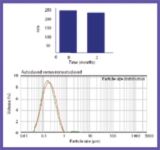
Figure 8: (a) Two-month stability data (differential light scattering) and (b) particle-size distribution (laser diffraction). The red line represents autoclaved, and the green line represents nonautoclaved formulations.
Tablet dissolution
Tablets of the micronized and nanosized material were made on the Presster compaction simulator for INV 1 and naproxen model compounds. The target tablet weight for INV 1 was 500 mg (equivalent to a 100-mg dose). The tablet target weight for the naproxen was 750 mg (equivalent to a 250-mg dose). The dissolution profile (dissolution media pH = 7.4) of nanosize naproxen tablets versus that of micronized naproxen tablets showed a considerably faster dissolution rate (see Figure 10a). The dissolution profile of the nanosize INV 1 tablets also showed a much faster dissolution rate compared with the dissolution profile of the micronized drug substance (see Figure 10 b).
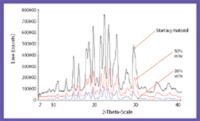
Figure 9: Powder X-ray diffraction of starting material and postprocessed material showing the retention of the polymorphic form.
Bioavailability studies
An in vivo study design approved by the International Animal Care and Use Committee was conducted for INV 2 in male beagle dogs (n = 6). The four formulations examined were the micronized solid dosage form (dvol50 = 6 μm), the nanosuspension (dvol50 = 200 nm), and nanonized capsule and tablet solid dosage forms (dvol50 = 200 nm). Each formulation containing a target dose of 200 mg (with 10 mL of water) was orally administered. The dogs received each of the four oral formulations during the first three weeks of the protocol, with 1 week between administrations. The dogs were fasted for 12 h before oral dosing. Approximately 2 mL of blood samples following oral administration were collected by means of jugular venipuncture at time intervals 0 (predose), 0.25, 0.5, 0.75, 1, 1.5, 2, 3, 4, 5, 8, and 24 h. Blood samples were collected into tubes containing ethylenediaminetetraacetic acid as the anticoagulant, mixed, and placed on ice until centrifuged. The resulting plasma was transferred to polypropylene vials for storage below -10 °C until analysis. The drug formulation and plasma samples were assayed for INV 2 using liquid chromatogray–mass spectroscopy–mass spectroscopy. Plasma concentration versus time data were analyzed, and the oral pharmacokinetic data were developed (see Figure 11).

Figure 10: Dissolution profile of (a) naproxen (unprocessed versus nanosized) and (b) INV 1 (unprocessed versus nanosized).
A 2–2.5-fold increase in onset rate, 4–9-fold increase in area under the curve (AUC) and 6–11-fold increase in maximum concentration (Cmax) was observed for the nanoformulations over the micronized formulation (see Table IV). The increase in rate and extent of absorption for the nanoparticle formulations was attributed to the increased dissolution and surface area compared with those of the micron sized particles of the milled formulation.
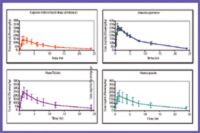
Figure 11: Mean plasma concentration of INV 2 in beagle dogs dosed orally in fasted state: (a) micronized capsule, 200 mg, (b) nanosuspension, 200 mg, (c) nanotablet, 200 mg, and (d) nanocapsule, 200 mg.
Conclusion
Nanoparticles can be achieved either by mechanical size reduction or controlled crystallization. This study demonstrates the feasibility of forming nanosuspensions using a modified modular high-pressure system, which is a mechanical approach capable of individually controlling cavitation, impact, and shear forces. By using complementary particle-size characterization techniques, we determined that stable submicron particles having a narrow particle-size distribution (i.e., a mean volume diameter <200 nm) could be formed by varying the equipment geometry and process duration at concentrations as high as 60% w/w. Increasing the drug concentration enhanced particle-size reduction as a result of particle–particle impact, attrition, and shear.

Table IV: Pharmacokinetic profile (INV 2).
Solubilization technologies continue to play an increasingly important role in enabling drug-candidate development and adding value to currently marketed products. By using nanotechnology, poorly water-soluble discovery compounds can be successfully formulated and developed, and marketed products may be revitalized with superior performance and patent protection.
Acknowledgment
The authors thank Zeri Teweldimedhin, Brian Samas, Parag Shah, and Dawn Wagner for supporting characterization-related activities.
Umang Shah* is an associate director at Pfizer, Inc., Ann Arbor, MI 48105, tel. 734.622. 4934, fax 734.622.7666, umang.shah@pfizer.comChandra Vemavarapu is a principal scientist, Vanessa Askins is an associate scientist, Mayur Lodaya is an associate research fellow, Paul Elzinga is a principal scientist, and Matthew J. Mollan, Jr. is a director, all at Pfizer.
*To whom all correspondence should be addressed.
References
1. H.W. Bosch et al., "Process for Preparing Therapeutic Compositions Containing Nanoparticles," US Patent No. 5,510,118 (1996).
2. G.G. Liversidge et al., "Methods of Making Nanocrystalline Formulations of HIV Protease Inhibitors using Cellulosic Surface Stabilizers," US Patent 6,068,858 (2000).
3. R.H. Muller, "Preparation and Physical Properties of Nanosuspensions (Dissocubes) of Poorly Soluble Drugs," Proc. Intern. Symp. Control. Rel. Bioact. Mater. 25 (1998).
4. G.G. Liversidge et al., "Surface Modified Anticancer Nanoparticles," US Patent 5,399,363 (1995).
5. D.E. Englund and E.D. Johansson, "Oral versus Vaginal Absorption in Oestradiol in Postmenopausal Women: Effects of Different Particle Size," Ups. J. Med. Sci. 86 (3), 297–307 (1981).
6. N. Kondo et al., "Improved Oral Absorption of a Poorly Water Soluble Drug, HO-221, in Experimental Animals," Biol. Pharm. Bull. 16, 796–800 (1993).
7. G.G. Liveridge and K.C. Cundy, "Particle Size Reduction for Improvement of Oral Bioavailability of Hydrophobic Drugs, I: Absolute Oral Bioavailability of Nanocrystalline Donazol in Beagle Dogs," Int. J. of Pharm. 125, 91–97 (1995).
8. BEE, Int. Electronic reference, retrieved Nov. 6, 2005, from http://www.beei.com/index.html.
9. T. Shechter et al., "Processing Product Components," US Patent 6,443,610 B1 (2002).
10. T. Shechter, "Forming Emulsions," US Patent 5720551 A (1998).
11. R.J. Hunter, Introduction to Modern Colloid Science (Oxford: Oxford University Press, 1993).
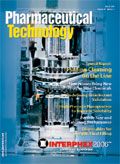
Drug Solutions Podcast: A Closer Look at mRNA in Oncology and Vaccines
April 30th 2024In this episode fo the Drug Solutions Podcast, etherna’s vice-president of Technology and Innovation, Stefaan De Koker, discusses the merits and challenges of using mRNA as the foundation for therapeutics in oncology as well as for vaccines.
Drug Solutions Podcast: Applying Appropriate Analytics to Drug Development
March 26th 2024In this episode of the Drug Solutions Podcast, Jan Bekker, Vice President of Business Development, Commercial and Technical Operations at BioCina, discusses the latest analytical tools and their applications in the drug development market.